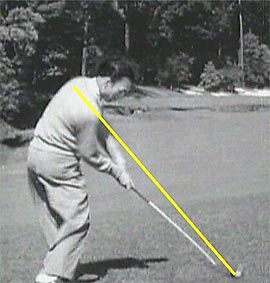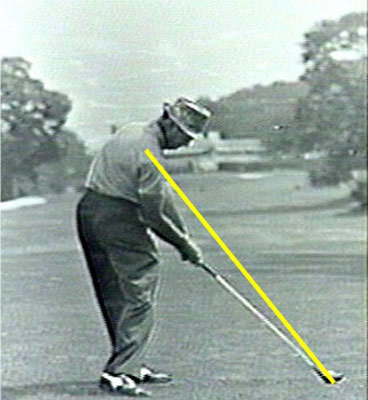Anyway, for those who don't understand the right forearm on plane, it means the clubshaft and the right forearm on inline with each other. Here's a pic of me doing that at address:

There's a few reasons as to why a golfer may want to get the right forearm on plane at address, but the main reason why I tend to do it is because I want to try and get the right forearm back on plane at impact. Mr. Snead and Mr. Hogan were quite good at it (thanks to Somax Sports for the pics)


Now, there are plenty of golfers who are very good ballstrikers who do not have their right forearm on plane at impact. However, if you do have the right forearm on plane at impact, I think you've greatly decreased your reliance on hand-eye coordination and have probably ensured a pretty good clubhead path thru the ball. And as I've discussed in my 'key golf swing concepts' series, you basically want to have good control over the attack angle (or the low point), the clubpath and the clubface.
Golfers tend to over work themselves on the plane a bit and get all sorts of gadgets to come up with the 'perfect' swing plane all the while they ignore attack angle and even more importantly, the clubface. By getting the right forearm on plane at impact, you've made it easier on yourself to ensure a pretty good downswing path. While backswing plane *can* play a role in what your downswing does, it's the downswing that hits the golf ball and it's where the golfer 'butters their bread.'
In the thread from

IMO, big stinking deal.
I think almost everybody would agree that the left wrist should be flat, yet I can show plenty of PGA Tour golfers will slightly bowed left wrists. The same with 'straight plane lines.' I could also argue that a 'stationary head' is completely bogus.
But the main point I'm making is that the concept itself is not invalid in helping *some* golfers play better golf and I think Brian Gay's objective is quite clear as to what he's trying to do at address, so who cares if he's a couple of degrees off from having the right forearm perfectly on plane? Especialy when it's helped him greatly improve his ballstriking and thus greatly improve his status on tour, in less than 2 years at the age of 37 years old.
The one thing that struck me funny was that *if* you have your right forearm on plane, you cannot make a full enough turn on the backswing. Does this look like a golfer struggling to make a full turn in the backswing?

Anyway, IMO the real key is if you can get the right forearm on plane at impact. If you struggle with your ballstriking and find that your right forearm in not on plane at impact, then I think you *probably* need to find a way so you can consistently get that right forearm on plane. And doing it at address *might* be a good way for you to go.
And in reality, once you do it for a couple of weeks, it no longer feels odd to you anymore and even further it will feel straight to have a straight right arm at address.
If there's a negative on the right forearm on plane at address it's that it can screw with your grip a little. If you like a neutral or a weak grip, then it will be difficult to do that with the right forearm on plane at address. Since I'm struggling with closing the clubface too early on the downswing, I am actually trying to weaken my grip a little and if that takes my right forearm off plane at address a little, I would take the tradeoff.
The other problem is discussed in this Michael Jacobs, GSED video.
While I disagree with Jacobs that it's 'not a good idea', merely because of golf's high rate of customization for golfers, I do agree that a golfer with the right forearm on plane at impact can start coming underplane which presents other problems, like shallowing out your attack angle a bit too much among other things.
If that's the case, then the simple solution is to start moving your right forearm above the plane at address and see if that works. If it doesn't, then you've probably hit the realm of having to understand how to 'swing left.'
The one thing I will go away with, and while it's certainly not an imperative or mandatory, I do believe that the golfer should have some bending in the right elbow at address. Here's a couple of famous golfers who did it as well.


Having the right arm flexed at the elbow at address I think allows the golfer the option of using the right forearm takeaway, but more importantly I think when any joint in the body 'locks' it tends to unlock in a way that it doesn't help the golfer. So having a little bend at address I think eliminates the process of unlocking the elbow.
In conclusion, there as much magic in being able to sense and feel and use the right forearm as there is in David Blaine's acts. But, it all customizable and the question is whether or not it works for you.
3JACK
This comment has been removed by the author.
ReplyDeleteI actually don't have a problem with you using my pic, but I don't like the fact that it has the GolfWRX stamp on it. I wouldn't care about that in most situations, but given the way they've treated me, they don't deserve one ounce of anything from this blog or myself.
ReplyDeleteAnyway, it's like I've said quite a bit about what I hear all of the time from critics of TGM. They usually claim TGM is a method and 'one way' of swinging the club which shows that they have never read the book. Then they claim that they don't teach 'one way' which in reality is what they do.
Frustrating.
I just couldn't get over the fact that somebody said you cannot make a good enough turn in the backswing with the right forearm on plane. That's never been an issue with me.
The absurd situation has turned out
ReplyDeleteAren't those pictures of Hogan and Snead fantastic?
ReplyDeleteI struggle with my own right forearm position at impact and would love to be more like these photographs.
As you say it's a customization on where you start with the right forearm - if it gives you the right feeling then it works - but for someone else with their swing faults or tendencies then it might not be so useful.
I cannot agree with the comments about inhibiting shoulder turn. But feel is not real they say and if someone feels it inhibits then that is one thing compared to actually inhibiting - which I don't think it would do.
Personally I like to feel that my right arm is relaxed and with a 'soft' bend in the elbow at address. I was tempted to try your customization to see if it would help my impact position but have not done so as I felt it might not help my axis tilt (i.e. I think it might give me more axis tilt and I don't want that).
Thanks, keep up the good work.
Wow, truly great topic. Where can I find that subscription?
ReplyDeleteKatty Flouee
spy store
The last straw will break the camel’s back.
ReplyDelete